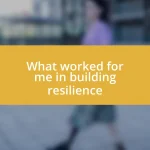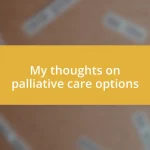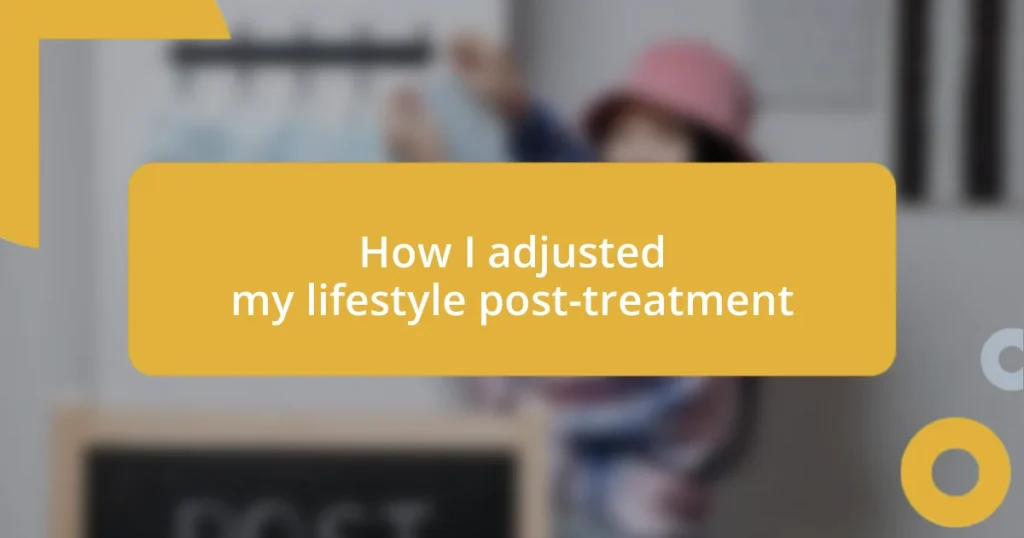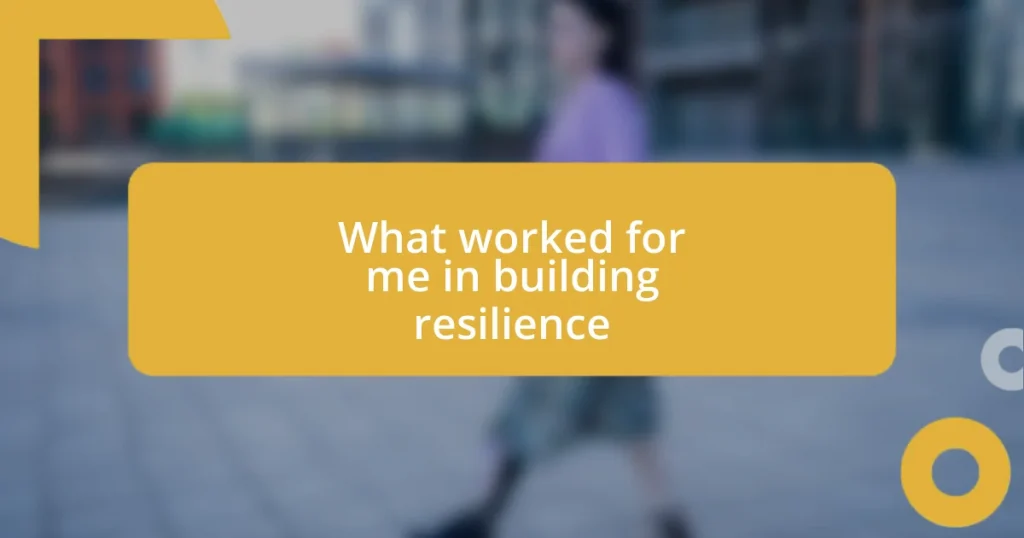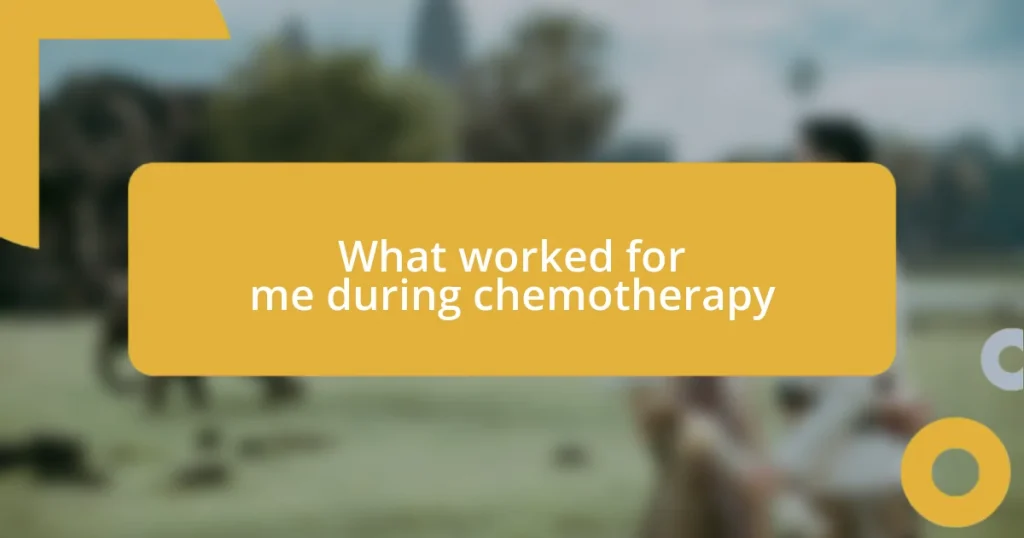Key takeaways:
- Acknowledging post-treatment needs and establishing a support system is essential for emotional healing and recovery.
- Incorporating healthy habits such as mindful eating, regular exercise, and stress management techniques fosters well-being and joy in daily life.
- Tracking progress and being flexible with routines allows for personal growth and adaptability in the recovery journey.

Understanding post-treatment needs
Understanding post-treatment needs can feel overwhelming, and I found myself questioning what came next. It’s not just about the physical healing; it’s an emotional journey too. I remember sitting alone one night, feeling lost; I realized that acknowledging my needs was the first step toward my new normal.
As I navigated my recovery, I discovered the importance of establishing a support system. Having friends and family who understood my situation made a world of difference. Can you think of someone who has been there for you during tough times? That connection can be a lifeline as you adjust to life after treatment.
I learned that self-care is not a luxury but a necessity. Initially, it felt indulgent to set aside time for myself, but then I understood the significance of mental wellness. Engaging in activities that brought me joy, like painting and journaling, became crucial in helping me rebuild my sense of self. How do you reconnect with what you love? Finding those small joys can be a powerful catalyst for recovery.

Identifying lifestyle changes
Identifying lifestyle changes was a pivotal part of my journey. I had to assess my daily routines carefully, understanding that not everything I loved was beneficial anymore. It reminded me of that time I turned down a dinner invitation because I realized that large gatherings drained my energy rather than uplifted me. It felt liberating to be honest with myself about what truly contributed to my wellbeing.
Here are some lifestyle changes I found crucial in my adjustment:
- Establishing Boundaries: I learned to say no to social events that I felt would overwhelm me.
- Prioritizing Rest: Understanding that fatigue is natural post-treatment, I started scheduling downtime.
- Mindful Eating: Nutrition became a priority, so I began choosing nourishing meals over convenience foods.
- Regular Exercise: I incorporated gentle workouts like yoga, which made me feel more grounded and connected.
- Creative Outlets: Reconnecting with hobbies like gardening provided a soothing distraction and a sense of accomplishment.

Creating a supportive environment
Creating a supportive environment was vital in my post-treatment journey. I realized that my surroundings profoundly impacted my mental state. For instance, I painted my walls soft, calming colors, which transformed my space into a sanctuary. When I entered my home, it felt like a warm hug after a long day. Have you ever noticed how colors can affect your mood?
I also made it a point to surround myself with positive reminders. I filled my space with photos of loved ones and inspirational quotes that resonated with my journey. Each time I glanced at these reminders, I felt a surge of motivation. It’s amazing how something as simple as a picture can ground you in gratitude and hope.
Most importantly, I learned to communicate my needs to those around me. I told my friends what support looked like for me—sometimes it was simply sitting together in silence, while other times, it was seeking someone to share a laugh. It took courage to be vulnerable, but that openness fostered deeper connections. Have you considered sharing your needs with those close to you? Building that trust can significantly ease your transition into a supportive environment.
| Supporting Elements | Description |
|---|---|
| Environment | Calming colors and clutter-free spaces promote tranquility. |
| Reminders | Photos and quotes reinforce positivity and motivation. |
| Communication | Openly expressing needs strengthens relationships and support. |

Establishing a daily routine
Establishing a daily routine became my anchor during this transformative time. I remember the first day I mapped out my schedule; it felt a bit strange, as if I were programing my day like a robot. But as I began to embrace the structure, I quickly realized it provided me with a sense of control and purpose. Can you relate to that feeling of liberation that comes from knowing what to expect each day?
In crafting my routine, I intentionally included both essential tasks and moments of joy. For example, I designated mornings for gentle stretching and fresh air, allowing those quiet moments to set a positive tone for my day. It’s fascinating how something as simple as a morning ritual can shift your mindset. Have you ever found comfort in the same little rituals? They can be so grounding.
Another aspect I embraced was flexibility within my routine. Life post-treatment comes with unpredictability, and I learned to adjust my plans as needed. There were days I felt particularly fatigued, and instead of pushing through, I allowed myself to take a restorative break. Listening to my body became an essential part of my practice. Do you find it easy or challenging to give yourself that kind of permission? For me, it was a game-changer, fostering self-compassion as I navigated this new chapter.

Incorporating healthy habits
Incorporating healthy habits into my daily life became a transformative journey. I started with something simple yet profound: hydration. I used to forget to drink water, but I placed a beautiful glass bottle on my desk as a reminder. It wasn’t just about the water itself; it became a ritual, a moment of mindfulness. Have you ever thought about how such small changes can positively influence your day?
Nutrition was another key component I focused on. I began exploring whole foods, shifting from processed snacks to fresh fruits and vegetables. Preparing colorful, nutrient-rich meals not only filled my body with goodness but also sparked joy in the cooking process. I vividly remember the first time I made a vibrant quinoa salad; the colors were dazzling, and it felt like a celebration on my plate. Have you tried experimenting with colorful ingredients in your meals? It can transform the whole experience of eating.
Physical activity, too, found its way into my new lifestyle. Initially, I approached exercise with reluctance, viewing it as a chore. However, I discovered that movement could be joyful rather than obligatory. I started with short, leisurely walks in nature, allowing the sights and sounds to invigorate my spirit. This gentle introduction made me realize how much I missed being outdoors. Have you ever experienced that blissful connection with nature? It’s a reminder that healthy habits can flourish when they’re rooted in joy rather than obligation.

Managing stress effectively
I found that managing stress effectively was crucial in my post-treatment journey, and one of the strategies I leaned on was mindfulness. I began setting aside just a few minutes each day to sit quietly with my thoughts. During these moments, I would focus on my breath, allowing myself to observe any stress without judgment. It’s surprising how just a short pause can create significant mental clarity, don’t you think? That experience opened a doorway to handling stress with more grace.
Journaling also became a valuable tool in my stress management arsenal. Each evening, I would reflect on my day, noting both the high points and challenges. I distinctly remember a night when I poured out my worries on the page, and the relief I felt was almost palpable. Have you ever experienced the cathartic release of expressing your thoughts in writing? It’s like untangling a knot in your mind.
On particularly overwhelming days, I turned to movement for relief. I often opted for dance—yes, just me in my living room, music up, and letting go. It felt empowering to shake off negativity and feel my body in rhythm once more. This simple act always reminded me to find joy in movement, no matter the form. Do you have a physical outlet that helps you manage stress? For me, those dance sessions became a powerful reminder that stress doesn’t stand a chance against something as joyous as music and movement.

Tracking progress and adjustments
Tracking my progress after treatment was a pivotal aspect of my new lifestyle. I began by maintaining a simple chart to log daily habits such as hydration, meals, and exercise. Each checkmark felt like a small victory, and I vividly recall the rush of happiness when I noticed my water intake steadily increasing. Isn’t it satisfying to visually see progress unfold before your eyes?
In addition to this, I started reflecting weekly on my emotional and physical shifts. Noting how specific changes affected my mood and energy levels gave me insight into what truly worked for me. I remember one week where I felt particularly energized after swapping out refined carbs for whole grains. Reflecting on that transformation reinforced my commitment—have you ever had a breakthrough moment that made you rethink your choices?
Lastly, I learned to be flexible with my approach. If something wasn’t resonating with me, I gave myself permission to adapt my strategies. I recall attempting a new workout routine that left me feeling drained instead of invigorated. Instead of forcing it, I switched back to my beloved nature walks. Isn’t it crucial to listen to our bodies instead of adhering rigidly to a plan? Tracking my progress wasn’t just about numbers; it was about building a lifestyle that felt right for me.

